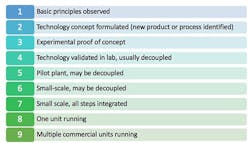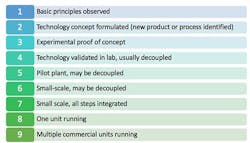Don’t Skip Development Steps
[pullquote]
The time will come when you need to try something new in your plant. This can range from installing a recently introduced variant of existing equipment all the way to building a unit for a first-of-a-kind process. Understanding the scope of the change and the various risks involved can help identify if opting for what’s “new” is a good idea or not. Let’s take “good” idea to mean one that has an acceptable economic return and meets all required safety, environmental and social license requirements. Today, we’ll focus on one extreme of this range, the first-of-a-kind plant or major modification.
Changes in the regulatory environment and incentives offered by various jurisdictions have made some projects very attractive — if they can work at proposed capacity and investment levels.
The traditional path for process development goes from idea to laboratory to pilot plant to small unit to full-scale plant. Every step requires work as new discoveries arise. Few ideas make it all the way to an operating plant.
The National Aeronautics and Space Administration formalized the path of technology development in the 1970s by defining nine technology readiness levels (TRLs). Figure 1 shows my adaptation that includes definitions more suited to the process industries. The break point between TRL levels should match step changes in operation where many problems occur. Technology should move to the next TRL level only after achieving success at the current level.
Figure 1. A successful technology typically goes through nine levels of development.
Only a miniscule fraction of the ideas that start at TRL 1 actually ever get to TRL 9. So, here, we’ll focus on technology that’s promising enough to have reached TRL 5 and what’s involved in moving it to TRL 9. These are the levels most likely to involve engineers experienced in commercial plants.
TRL 5 is a pilot plant that succeeds in making the sought-after product at the desired conditions. If multiple steps are required, each may run independently, with the product from the previous step sent to storage until needed.
TRL 6 involves operation of a small-scale unit. Here, small-scale means a plant built using the smallest size of typically available industrial equipment that gives a reasonable scale-up to a full commercial unit.
TRL 7 mainly differs from TRL 6 by integrating units. Most commercial processes try to avoid intermediate storage because it increases equipment costs, plant size, working capital needed, and can create safety and quality problems with stored intermediates. Making a flow-through process with minimum storage always is an attractive option. A key step in the small-scale plant is developing operating procedures for handling startup, shutdown, unusual events, quality changes and other operating conditions.
TRL 8 scales up from a small plant to a full economic-capacity unit. It uses normal-size equipment. Standards and procedures developed in the small-scale unit are the starting point for further development.
Finally, at TRL 9, the demonstrated success of one plant leads to building others. Experience gained from the first unit may enable improvements in economics, safety, quality and other performance areas.
Most process developers are optimists. Most process developments fail. Perseverance in spite of repeated failure requires a certain character and outlook on life. This same optimism can lead developers astray, though. If the economics look attractive enough, companies may skip steps. Some recent clients have been tempted to do the equivalent of jumping from TRL 5 (pilot plant, decoupled) all the way to TRL 9 (multiple units running) to grab a current opportunity.
I reckon (based on observation, not statistics) that 15% is on the high side of the probability for success in getting from TRL 5 to TRL 9, even when doing all the steps. And the jump, even if successful, likely will incur much higher development expenses. The cost of figuring out how to make larger equipment work and the costs of off-performance operation on larger stream flows rapidly escalate.
Process industry history is full of seemingly good ideas that took their investors to their financial graves. Before making the decision to skip development steps, truly think through the consequences of units that don’t work and devise plans to mitigate financial and performance risks.


